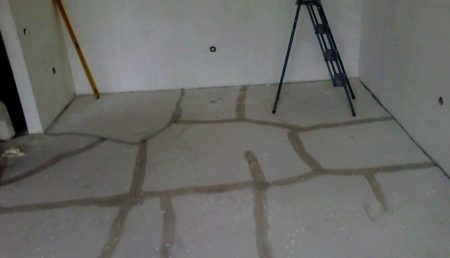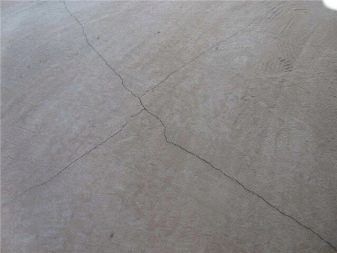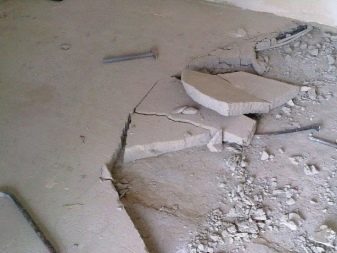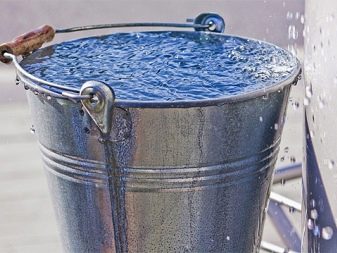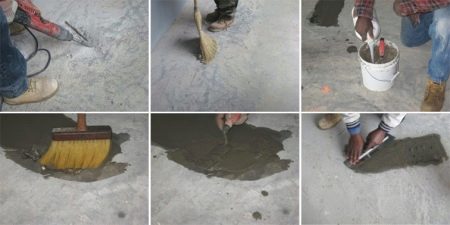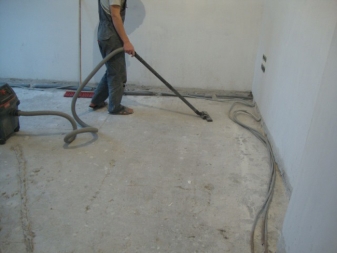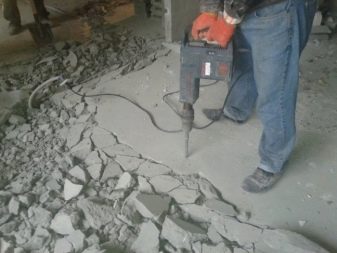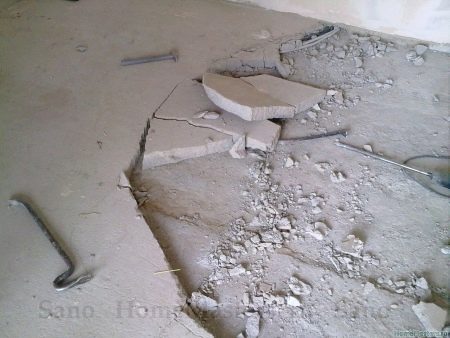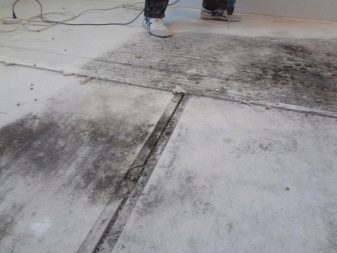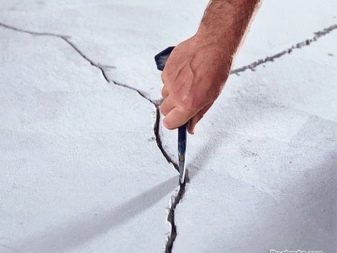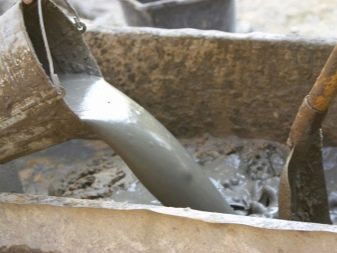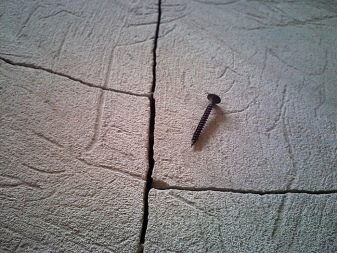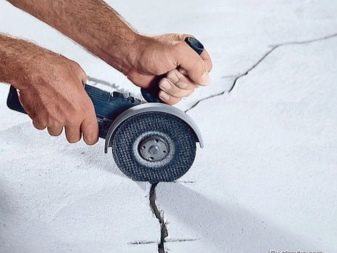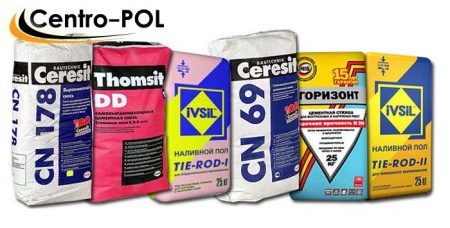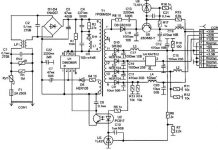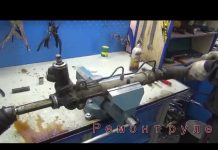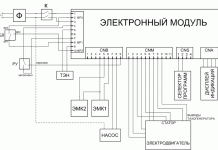In detail: DIY repair of floor screed cracks from a real master for the site my.housecope.com.
The content of the article:
- Condition assessment
- Preparation of the mixture
- Repair technology
- Minor defects
- Deep cracks
- Delamination
- Potholes
- Dusty screed
Cement screed is the outer layer of the sub floor. Over time, for many reasons, it wears out, but the floor covering laid on top does not give timely identification of the defects that have arisen. In the process of replacing it, when the base is exposed, the hidden problems of the floor become apparent, and it becomes necessary to repair the cement screed. You will learn how it works in this article.
The floor screed is subjected to tremendous stress from the weight of the flooring, furniture and equipment, as well as dynamic effects from falling objects and walking by people. Therefore, the service life of an expensive floor repair largely depends on its condition. The money invested in this event can be wasted if a neglected screed makes itself felt.
Reliable information about the condition of its surface can be obtained only after complete cleaning of the floor from the old coating, debris and dust. To determine the degree of damage to the screed, there are the following criteria:
-
The screed is even, but has small indentations, a network of small cracks and is constantly dusty. To eliminate such damage, an investment of significant funds is not required, since such work can be done independently.
The surface of the base has delamination and in some places is covered with deep transverse or longitudinal cracks, but their average size does not exceed? the length of the short wall of the room. Such a screed can also be repaired independently, but this will require building mixtures with a special composition.
| Video (click to play). |
The screed has significant curvature, expressed in numerous depressions and humps. To level such a surface, a milling machine will be needed, which creates a lot of noise and dust during operation. Therefore, the repair of such a foundation is recommended only in non-residential premises or private households. In city apartments, neighbors may not stand the discomfort from the work of technology, complain or go in person.
Redecoration of a cement floor screed is performed if no more than 30% of its area is damaged. In other cases, it is better to replace it completely.
Today the construction market has a huge selection of mixtures designed for the restoration of cement screeds. These formulations can be based on a variety of bases, including polyurethane and synthetic resins. Many of them are used to renovate industrial floors. But in an ordinary apartment, the use of such mixtures is not always rational, given their cost.
For a simple repair of the screed at home, a mixture that can be made independently from affordable and inexpensive materials is quite suitable. It contains PVA glue, water, sand and cement. To prepare a repair solution, you first need to dilute the PVA glue in water in proportion to 1: 3, and then add a dry mixture of cement and sand 3: 1 to the resulting emulsion.
The composition should be mixed at minimum speed for 5 minutes using an electric drill with a mixer attachment.After the end of the process, it is recommended to immediately immerse the mixer in the water poured into the bucket and rinse well with the operating mode of the tool.
If the cracks in the screed are deep, such a composition will not work. To repair it, in this case, you will have to buy a special thixotropic liquid for concrete. Store-bought ready-made mixtures are mainly mixed with water, and home-made compositions are mixed with an adhesive suspension. Ready mixes can be replaced with tile adhesive.
All screed defects, such as shallow and deep cracks, delamination and dust formation, potholes and depressions, are eliminated in various ways, which we will consider below. In the meantime, the following tools and materials must be prepared for work: a perforator, a trowel and, as a rule, a brush, a trowel and a paint roller, cement, a primer for concrete and a repair mixture.
These include small cracks, gouges and chips on the surface of the cement screed. The reasons for these defects are mistakes made during its installation: the absence of expansion joints, poor-quality grout or insufficient reinforcement of the base.
To repair a cement-sand screed with small defects, you first need to mark all problem areas with chalk, and then cut each crack and recess with a hammer and chisel a few millimeters in depth and 1-2 cm in width at the edges. After that, you need to remove construction waste from the surface of the screed with a broom, and from the cracks with a vacuum cleaner.
Cracks and gaps should be treated with a penetrating primer several times until it is no longer absorbed into the concrete. This procedure is necessary to increase the adhesion of the base with the repair mortar.
While the primer is drying, you can prepare the mixture according to the recipe described above. The resulting solution should be used to fill the cut damage of the screed just above the general level of the rest of the surface, and after the mixture hardens, grind the repaired areas.
Such damage to the screed must be cut to the full depth. For this purpose, it is recommended to use a circular saw and a hammer drill, it will be unproductive to work with a hammer and chisel.
After the crack is cut, several strobes must be made across it, the ends of which will extend beyond the resulting cavity by 5-6 cm on each of its sides. Then, at the two ends of each groove, holes should be drilled 2-3 cm deep, and then remove the debris and clean the cut cracks with a vacuum cleaner. Prepared grooves must be primed and left to dry.
Now you need to prepare a mortar of sand and cement in a ratio of 3: 1. Filling the crack should be done gradually in several stages. In the first of them, a liquid mixture is used, which must be filled in part of the cavity in depth so that it penetrates into the most inaccessible places of the excavation.
Then you need to prepare a solution of medium density and fill the crack with it flush with the bottom of the transverse grooves. When it hardens, it is necessary to make staples from thick wire or reinforcement to tighten the crack and mount them in the grooves so that the bent ends of the rods go into the drilled holes.
After that, a little plasticizer must be added to the solution and filled to the end of the cavity along with the staples. Then the surface in the area of the former crack must be leveled, and after the solution has dried, it must be sanded. Now the repair of the crack in the cement screed can be considered complete.
Delamination and even swelling of the screed occurs when it is laid on a dirty and not primed floor. Such defects can be detected using a light hammer or piece of reinforcement. To do this, it is enough to tap the surface of the screed with this tool and determine the place of the defect by the dull sound of the impact. When the screed peels off, gaps may appear through which, with this diagnostic method, clouds of dust will fly into the air.
Detachment repair can be done in two ways. In the first case, the entire damaged area must be cut out, and a new screed must be laid in its place. In the second, the exfoliated area is injected, during which a special binder based on an epoxy or adhesive base is introduced under it. The second method is less laborious and faster. It makes sense to use it if the problem area is flat and does not have through cracks.
After determining the places of screed delamination, they need to be outlined with a marker or chalk, then take a punch or drill and install a drill or a concrete drill with a diameter of 16 mm in any of these tools. Drilling in places of delamination should be carried out for the entire thickness of the screed, observing the distance between them 0.2-0.3 m.
When this work is completed, you need to pour a primer into the holes obtained. He must wet the entire internal cavity between the base and the screed layer. To make the process of drying concrete faster, you can use a construction hairdryer.
It is important to correctly identify the material for the injection screed. It must have good fluidity, because the repair mixture will have to be pumped under the screed using a plunger pump or a construction syringe. A cement-glue mixture will cost less, a low-viscosity epoxy resin is more expensive, but more reliable.
Injections through the holes in the screed must be carried out gradually, giving time for the repair compound to fill the entire space of the cavity. This procedure should be continued until the mixture appears on the surface of all drilled holes and its level stops dropping.
The screed must dry for 24 hours. After that, you can work with it further: priming, gluing linoleum, laying tiles and so on.
This damage occurs due to a violation of the technology of the screed device and significant loads on the base. In the presence of such factors, during the operation of the floor, voids appear in the screed. They are more dangerous for the floor covering than cracks. In areas of potholes, the floor suffers a subsidence and deforms, which leads to its further complete destruction.
In this case, for repair, it is first necessary to cut through the pothole with a "grinder" equipped with a diamond disc, along the perimeter of the damage to the entire thickness of the screed. Then, using a hammer drill or chisel and hammer, remove the concrete from the pothole. After that, the cavity must be cleaned of screed residues and dust, and then treated with a penetrating primer.
After the primer has dried, it is necessary to prepare a repair mixture and fill the pothole with it using a spatula. Without waiting for the mixture to dry, use a wide spatula and lath to level it to the floor and leave until the final polymerization. Grinding the problem area should be done so that the pothole filled with the mixture does not stand out against the background of the floor.
Over time, cement-sand dust begins to appear on the screed. This is especially evident in those rooms on the floors of which the screeds serve as a topcoat, for example, in the basement, garage or any other utility room.
Gradually, the amount of dust increases, and it becomes impossible to simply sweep it away. It is often the result of significant mechanical stress on the surface of such a floor and its "old age". In other cases, dust appears immediately after a month or two after starting to use a new screed. The reason for this is the low quality of the cement mixture and violations in the technology of its laying. If it is not possible to replace the tie, it can be repaired in the following way.
First, you must thoroughly clean its entire surface with a vacuum cleaner. If at the same time potholes and cracks are found, they must be repaired using the above technology. After that, the screed must be sanded and cleaned again in the same way. The floor surface should then be treated with a penetrating primer and allowed to dry.At the final stage of work, the entire screed must be covered in two layers with a polymer composition. If the room has high humidity, special water emulsifiers must be used for this purpose.
There is another way to eliminate screed dust - painting it. In this case, the coating must be sufficiently wear-resistant; according to this parameter, the finishing material should be chosen.
The cardinal method of such a screed defect is its reinforcement with the help of fiberglass and subsequent pouring with a special self-leveling building mixture. To implement this method, the floor surface must first be cleaned with a vacuum cleaner, primed and allowed to dry.
After that, glue should be applied to the surface of the screed and the fiberglass fabric should be overlapped. When the first layer of glue is dry, the second layer must be applied to the resulting coating and allowed to completely cure. The floor can then be sanded or poured over the fiberglass with a self-leveling compound.
How to make a cement screed - watch the video:
Floor screed repair is a fairly common type of repair work. The sub floor is under significant stress, as a result of which it gradually wears out and weaken. You can strengthen the concrete base and eliminate defects yourself.
The most common sub-floor injuries are:
- general loosening of the screed... It is characterized by the appearance of a large amount of cement dust as a result of a violation of the technology for preparing a solution or a low quality of cement;
- potholes and cracks... Formed due to excessive point load on the floor surface. The presence of voids in the top layer of the concrete base also causes the screed to crack and deform. This defect is considered the most dangerous for decorative flooring: the area located above the damage and devoid of solid support quickly deteriorates and collapses;
- exfoliation... Diagnosis of this malfunction is made by tapping the floor surface with a hammer. On the exfoliated areas, the sound from the impact will be muffled, and dust will begin to come out through the cracks formed. Delamination can be expressed in the visual swelling of the top layer and the raising of the corners after the mortar dries. The reasons are often uneven drying of concrete, the absence of a primer layer under the base and the use of low-quality cement;
- excessive dust formation... Due to excessive loads and general aging of the screed, a large amount of cement dust is formed on its surface. Sometimes dusting the floor is associated with poor quality cement and a violation of the pouring technology.
Mixes for the restoration of cement screed are widely represented in the modern construction market. They include polyurethane components and synthetic resins and are more for industrial use. When carrying out repair work in an apartment, the purchase of expensive compositions is not always rational, therefore for minor repairs, the mixture can be prepared by hand.
This requires mix PVA glue with water at the rate of 1: 3, then add one part of sand and three parts of cement... The resulting composition should be carefully moved using a construction mixer or a drill with a paddle attachment.
Homemade cement mix can be used to repair shallow cracks and shallow potholes. To carry out large-scale repair and restoration work, you need to purchase professional tools.
To strengthen the subfloor screed, it is necessary to drill a number of holes equidistant from each other at a distance of 25 cm and having a diameter of 20 mm with a hammer drill. The depth of the channels made should be equal to the thickness of the screed. Work should be carried out using a drill with a small angle of inclination of the working groove. The openings should be cleaned of dirt and, if possible, dust-free.... Next, you need to prepare cuts of reinforcement, equal in length to the depth of the channels and having a diameter of 12 mm.
Then a mixture of epoxy for concrete "Rizopox-350" and quartz sand should be poured into the holes, then iron rods should be inserted. The fittings must be degreased beforehandb. The upper, widest part of the canal is also carefully poured until it is level with the base. The installation of the decorative coating can be started after complete drying, subsequent dust removal and priming of the screed..
In the presence of a "warm floor" system, this method of strengthening the screed is not suitable: drilling the channels can damage the cable and the thermomat, as well as pierce the water heating pipeline.
After the diagnostics of the appearing detachments, as well as in cases when the screed is swollen and "swollen", it is possible to start repairing it only if the damaged surface is no more than 30% of the total area of the self-leveling floor. There are two ways to repair detachments. The first is to carry out point injections using a liquid repair mixture. and consists of several stages. Initially, you should identify problem areas with the help of tapping and outline them with chalk. Then, in the places of delamination, channels with a diameter of 15 to 20 mm are drilled. The distance between the holes should be 25-30 cm.
Further, the channels should be dedusted and filled with a primer mixture, trying to evenly moisten the entire surface of the inner cavity. At the end of the pouring, you need to dry the treated surface with a construction hairdryer. As a material for injection, you can use cement-adhesive mixtures or epoxy resins..
An important condition for the maintainability of the solution is good fluidity. A construction syringe or plunger pump can be used to fill the channels.
Injections should be carried out slowly, allowing the solution to be evenly distributed throughout the entire internal cavity. The procedure should be carried out until the upper part of the channels is filled with the mixture to the floor level.... The repaired screed should dry for at least a day, after which you can proceed with priming and the subsequent installation of the topcoat.
The second way to repair a delaminated screed is to completely dismantle the problem area, dust removal and priming of the surface, followed by concrete pouring. The method is used in cases of impossibility of spot repair with a large area of the damaged area.
Cracking of the screed surface can occur from uneven load on the topcoat, impacts and poor wetting of the concrete base during drying. If the floor surface is cracked, burst or crumbles badly, emergency measures must be taken, because it is the cracks that are the most serious defect in the screeds. To fix the problem, you need to deepen and widen the crack with a grinder until you get strong edges, while using a disc for working on stone. Then cut grooves perpendicular to the direction of the crack, 2 cm deep and 15 cm wide. The surface of the recesses is carefully dedusted and primed.
Further the crack must be filled with a repair compound to half its depth and a metal bracket must be installed. To increase the strength of the solution, you can add quartz sand to it. After filling the main crevice, it is required to fill the transverse grooves with mortar and remove excess mortar. Then you need to wait until the repaired surface is completely dry and start sanding it.
When repairing deep cracks, it is necessary to drill out their cavity to the entire depth of the screed. When forming transverse grooves at the ends, you need to drill holes 2-3 cm deep. It is necessary to fill in a deep crack in several steps, giving each layer time to harden as much as possible.... The first batch of the mixture should be made slightly thinner. This will allow it to penetrate into the most difficult-to-reach areas at the base of the floor and fill them evenly. The next batch should be of medium density, it should be poured into the crevice to the level of the transverse grooves.
After the second layer has set, you need to install the tightening metal brackets, securing their ends in the drilled holes. Then a plasticizer is added to the solution and a final pour is made, which will hide the bracket underneath... After the solution is completely dry, the repaired area is polished and the screed is prepared for the installation of a self-leveling floor or installation of a floor covering.
An even floor is a prerequisite for renovating an apartment. It is important to keep it in good condition after renovation. If the floor has undergone deformation, it is necessary to find out and eliminate its cause, to repair the floor screed.
The floor screed, even if it was made exactly in accordance with the competent instructions, eventually deteriorates. This is not surprising, because it experiences enormous loads from the weight of the flooring, furniture, movement of people and other dynamic influences. Therefore, to prevent a complete loss of its operational properties, it is periodically necessary to repair the floor screed.
To get an idea of the degree of surface deformation, you must first completely remove the old coating, clean the floor from debris, dust and dirt. Next, you should decide on the type of deformation and repair that will need to be done.
One of the following may occur:
- The flat surface has small pits and some cracks, the level of dust formation is increased. These damages are not scary, they are easily repaired with minimal loss of time and money.
- The screed is peeling off, the surface is cracked deep enough in some places. This type of deformation must be repaired, but it will be necessary to use special building mixtures.
- The surface is significantly curved, the floor is covered with deep cracks. Repairing damage of this magnitude is available only to professionals with the appropriate skills and techniques.
Before proceeding with the repair, you should pay attention to some procedures that will tell you which way to eliminate flaws is suitable in each case. Necessary:
- identify the cause of the deformation;
- identify the presence or absence of expansion joints (if they are not there, then it is necessary to take care of the gasket);
- determine the method of pouring the cement mixture and the type of base on which the floor was laid;
- find out if the concrete is flaking by tapping the surface with a hammer.
These recommendations must be followed in order to avoid the reappearance of flaws in a month or two after the repair. If the work is done poorly, there is a risk of cracks, potholes and "coiling" concrete returning.
Before starting the repair of the floor screed, it is necessary to determine the type of damage itself. This can be done by removing the floor covering. Visual assessment of defects will help to identify the specific type of damage, which will allow you to quickly select the right tools and start repairs.
The main types of damage include:
- detachment of the screed (in whole or in part) from the base of the floor;
- irregularities, potholes, cracks and pits on the surface;
- excessive dust formation, which means weakening of the screed material.
The reasons for the appearance of defects can be very diverse. It is necessary to pay special attention to them in order to avoid similar mistakes and further destruction of the screed in the future.
The most common reasons are:
- Violation of the mixing technology. Most often this happens when using a ready-made mixture. It is recommended to strictly follow the manufacturer's instructions, as incorrect proportions lead to a deterioration in the quality of the mixture.Also, do not knead the solution manually - for this purpose it is better to use a special attachment for an electric drill or a construction mixer so that the existing substances are mixed evenly.
- Fast drying. When working with concrete, you should always remember that its durability and strength directly depend on contact with water. The cement floor should not dry too quickly, periodically it should be sprayed with a small amount of water and covered with polyethylene so that the top layer does not become dry before the concrete is completely cured.
- Excessive amount of water in the solution. Excessive water in the concrete mix, firstly, deforms the concrete itself and reduces the strength of the screed. Too much water ultimately causes the screed to crack and the surface becomes loose. To avoid this, after the concrete dries, the screed must be covered with deep penetration soil, which will entail new costs and increase the repair time.
Most often, defects appear precisely in the cement screed; when using semi-dry mixtures and gypsum compositions, the likelihood of cracking is significantly reduced.
- No expansion joints. Incorrectly laid expansion joints or their complete absence most often cause the surface to crack. It is recommended to fill the wall joint with an elastic material such as polypropylene foam. It is located along the thickness of the screed, and this reduces the effect of wall loading on it. Intermediate seams divide the screed into equal parts, passing through half of its thickness.
- Lack of damper tape. The presence of an edge tape is especially important when pouring a screed for a warm floor. When heated, concrete tends to expand, thereby creating additional pressure on the walls. Thus, the absence of a pressure compensating tape can cause the destruction of not only the screed, but also the walls themselves.
- Poor quality reinforcement. The main rule when installing reinforcement is its location in the concrete, and not under the screed.
There are many other factors that lead to the destruction of the screed. Most often it is the poor quality of the mortar, poor-quality cement mixture used in construction, violation of the pouring stages. Delamination of the screed can be caused by local shock loads, improper surface preparation for pouring with concrete.
Whatever the error, do not ignore the revealed deformation of the screed. Small repairs at the initial stage of destruction will keep the floor intact and save a significant amount on its subsequent restoration.
The above types of deformation lead to the fact that the screed begins to crack. This is bad because over time, even the smallest depressions expand, because of them you will have to make major repairs to the floor. Cracks are one of the most severe types of destruction, requiring urgent removal, therefore, they must be eliminated in a timely manner. Cracks are small and deep.
Small-diameter cracks are considered to be damage up to 2 mm wide.
You can repair the screed with your own hands as follows:
- Use a grinder to widen and deepen the crack. Particular attention should be paid to the fact that after expansion, the edges of the cracks should not crumble, but should be absolutely hard. If it is not possible to use a grinder, you need to stock up on a hammer and chisel.
- After expansion, the cracks must be cleaned. For this purpose, only a construction vacuum cleaner is used.
- The abraded areas are coated with an epoxy primer. This must be done several times until the mixture is completely absorbed into the concrete.
- After the primer has completely dried, the damaged areas are filled with a mixture of Rizopox 3500 and quartz sand. The mixture should fill the crack just above the surface.
- After the mixture has hardened, the repaired areas are sanded and cleaned.
To close up very small cracks, you can refuse to buy ready-made mixtures and use ordinary tile glue or a mixture for a self-leveling floor. However, it must be borne in mind that this method is unacceptable when repairing a screed in rooms with high humidity.
Repairing minor damage takes little time and requires no special tools.
If large cracks have formed in the screed - more than 2 mm in width - the repair process will proceed as follows:
- As in the first case, the cracks must be cut to the full depth.
- After expanding the crack across it, it is necessary to make several strobes.
- Small repair seams (1.5 cm long) are made along the grooves with an interval of 2 cm.
- Prepared grooves should be cleaned with a construction vacuum cleaner, primed and left to dry.
- After the primer has dried, the repair joints will need to be filled with pieces of reinforcement, metal staples or wire.
- Further, the cavities are filled with a liquid mortar from a mixture of sand and cement. The surface is leveled with a strip and sanded after drying.
One of the main tasks of renovating an apartment is getting a flat floor. Whatever the external coating, this problem cannot be solved unless the floor screed is repaired. Only with a high-quality screed will the floors look perfect.
The floor screed, like any coating, requires repair, which must be done in a timely manner so that it does not need to be completely replaced.
Self-repair of the floor screed is not a very difficult task, but it will require the application of certain physical efforts and will require material costs. These inconveniences should not stop the owner. Any coatings age over time and become covered with obvious and hidden defects, but it is much more profitable to make timely partial repairs than to completely replace the screed when its destruction intensifies.
Diagram of the screed pouring process.
In any room, there is a floor screed between the finishing flooring and the floor slabs. It is usually made of concrete mortar of various thicknesses. In modern designs, a special mixture is used for self-leveling floors. The floor screed itself is hidden under the floor covering and therefore may appear to be intact. However, in fact, the main task of the concrete pavement is to take on the main mechanical load acting on the floor. It is a damping layer for overlapping. Constant mechanical stress naturally leads to the gradual destruction of the floor screed material.
An important role of the screed is that it levels the surface and thereby ensures the horizontal and evenness of the outer floor covering and increases its durability. In addition, the concrete coating is designed to hide various communications: electrical wiring, pipes, floor heating, etc. Finally, the screed is an additional layer that provides thermal and acoustic insulation. The role played by the coating in ensuring the quality and reliability of the floor is enormous, therefore it is so necessary to independently monitor its condition and ensure its operability.
Under the influence of various loads or due to poor manufacturing, the floor screed is subject to destruction. When removing the upper floor covering, all the defects that have arisen become visible and can be assessed as a possibility to repair the floor with your own hands. The main types of screed damage include the appearance of noticeable cracks or potholes, peeling of concrete from floor slabs in some areas with the appearance of air gaps, minor cracking, peeling or the appearance of small cavities and holes along the surface of the screed.
Cracks, and sometimes large gaps, are formed due to uneven or shock loads, as well as due to violations during construction: the absence of shrinkage joints, insufficient reinforcement or poor-quality concrete pouring. Such damage is very dangerous because of its tendency to increase the size and number of cracks. When removing the floor covering, these defects are visible to the naked eye.
Potholes and large cavities appear in areas of local powerful loads (for example, vibration of household equipment) or in places where a void appeared in the concrete when it was poured. Peeling of concrete from the floor can occur with uneven loads or poor surface preparation before pouring concrete. Such damage is imperceptible from the outside and can be identified by a dull sound when tapped with a hammer. Poor-quality concrete or violations of the pouring modes are the cause of multiple surface damage, which manifests itself in the form of peeling of the screed surface, its strong dustiness or small cobweb-like cracks.
All the types of damage considered can be repaired with their own hands on the floor screed in certain areas. The only condition for the expediency of its implementation is the disadvantage when more than 35% of the screed surface is damaged. In this case, it is recommended to completely replace the screed.
Small cracks in the screed can be covered with ordinary concrete mortar.
Do-it-yourself repair of small visible cracks in the floor screed is carried out in the following order. With the help of a chisel, the crack expands and deepens by 10-15 mm. The crack and the area around it are thoroughly cleaned of dust with a vacuum cleaner. A solution of epoxy primer in a solvent (ratio 1:10) is applied to the crack surface and dried. This surface treatment improves the adhesion of the grout to the crack surface. After that, a solution is poured into the crack or gap, which is a special mixture for screed self-leveling floor. The dried area is sanded.
Small cracks in the screed can usually be repaired using cheaper conventional cement-based primer and plaster mixes. However, such repairs are likely to be short-lived, as the cause of the previous damage remains. The use of mixtures on an epoxy or other synthetic adhesive base significantly strengthens the hazardous area and allows you to neutralize the crack formation center.
Step-by-step repair of large cracks in the screed.
Large and deep cracks in the floor screed must also be repaired. For this, the cracks with the help of the grinder are expanded and deepened to the floor slab or to a depth of at least 50 mm. On the lateral surfaces, grooves are filled in the cracks. The widened crack is thoroughly cleaned of dirt and dust. Along the crack, grooves 15-20 cm long and 20 mm deep are punched perpendicular to the crack. The distance between the grooves is set at 20-30 mm. The crack and the adjacent area are thoroughly cleaned with a vacuum cleaner. As in the case of small cracks, the entire area of a large crack is treated with a primer mortar.
Sealing of large cracks is carried out with a mixture for a self-leveling floor screed or with a special epoxy mortar for concrete (for example, the Rizopox-3500 brand) filled with quartz sand. The crack is filled in two stages. First, the crack is filled to the depth of the beginning of the grooves. Metal brackets are installed in the transverse grooves in a vertical position. The final pouring of the solution into the crack is carried out after the first layer has dried and the metal brackets are fixed in it. When repairing especially deep cracks, grouting can be carried out in three stages. At the end of the drying of the screed repair section, all irregularities are eliminated by cleaning and grinding.Such repair of cracks in the floor screed with your own hands allows you to ensure the reinforcement of a hazardous area with metal elements, which eliminates the risk of re-formation of cracks or cracks.
A screed hole can be repaired with a special resin based sealant.
Potholes on the surface of the coating can occupy a significant area. Do-it-yourself screed repair in this case is carried out in several stages. First, with the help of a grinder, cuts are made around the perimeter of the pothole with a depth of 2 cm greater than the depth of the pothole. If the depth of the pothole is large, the slots are made to the bottom. Then, using a hammer drill, the screed concrete is removed within the marked perimeter to the depth of the slot. The formed recess is thoroughly cleaned of concrete residues and dust with a vacuum cleaner.
In the next step, the bottom and walls of the recess are covered with a primer. After it has hardened, it is poured with repair mortar in several layers. The thickness of each layer is usually selected within 20 mm. Each layer is poured after the previous one has hardened. For large repair areas, it is advisable to reinforce the repaired area with metal rods, mesh or synthetic threads. After the top layer of the mortar has completely solidified, the entire repair area is cleaned and sanded so that its surface is strictly level with the surface of the floor screed.
By tapping with a hammer, it is necessary to clarify the zone of delamination of the concrete of the floor screed from the floor slabs. The boundaries of the zone are marked with chalk or colored markers. Inside the marked area, holes with a diameter of about 20 mm are punched through the concrete of the screed to the floor surface. The distance between the holes is 25-30 cm. The number of holes is determined by the peel area.
The principle of repairing such damage is based on the fact that an air gap forms in the area of concrete delamination from the base and it must be filled with mass. For this, the grouting solution is diluted to a liquid consistency and poured into a construction syringe. Through the punched holes, the mortar is fed into the delamination zone and must completely fill it, ensuring the adhesion of the screed and floors to the concrete.

